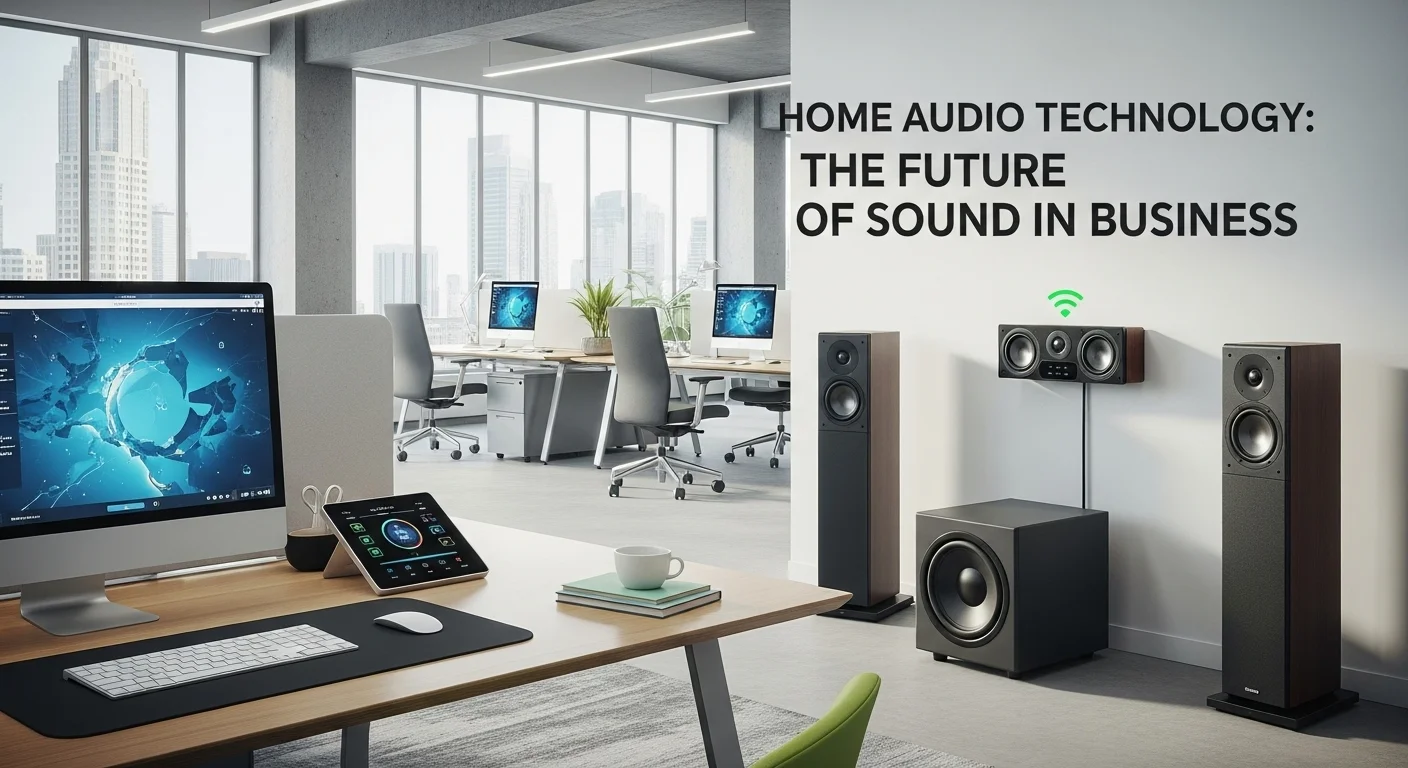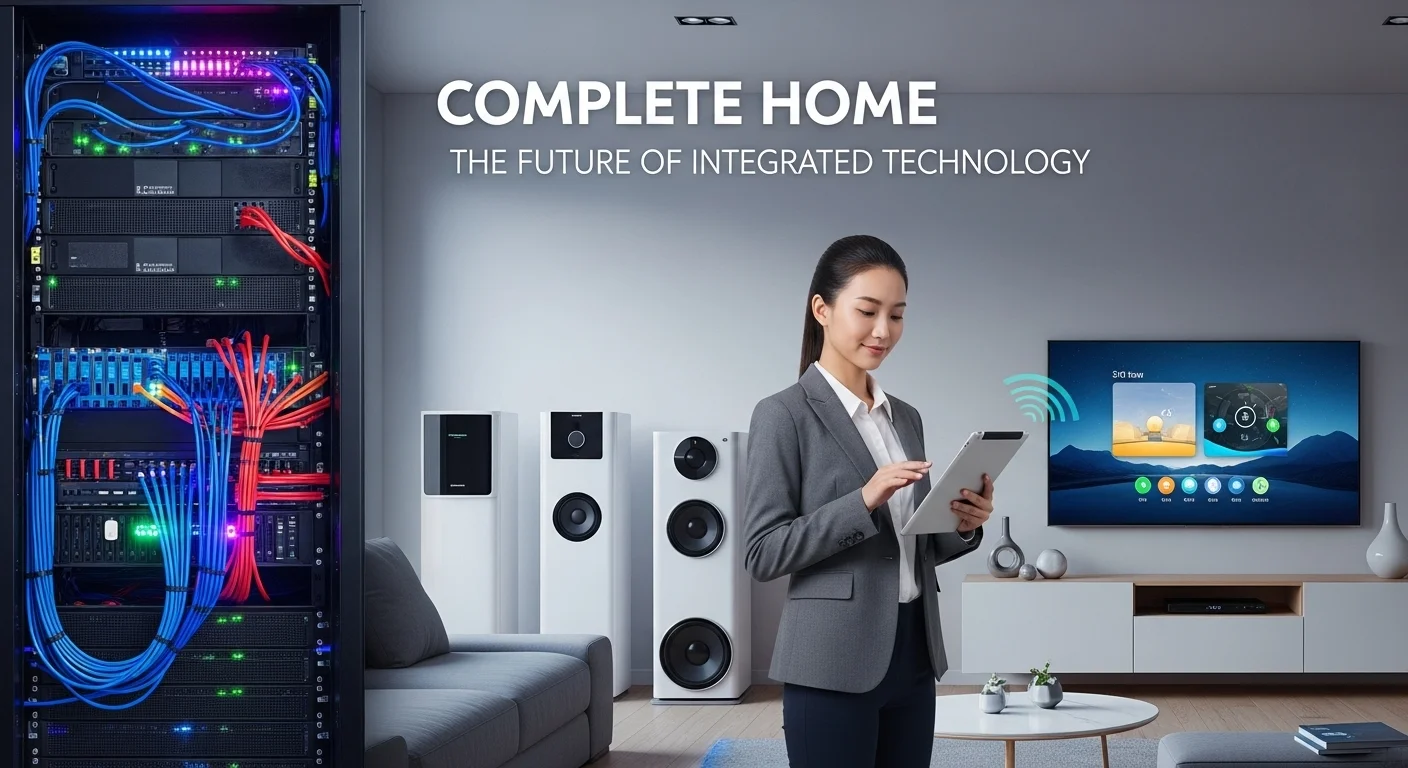The Future of Sound: How Smart Audio Is Reshaping Our Homes and Businesses

Executive Summary
Let's be honest, the world of audio technology has gotten complicated. It's no longer just about a pair of speakers; it's about creating an entire sound environment. I've spent years installing and designing these systems, and I'm here to demystify it for you. This article is your guide to modern 'Home Audio'—a term that now covers everything from high-fidelity speakers to the incredibly smart control systems that run them. We'll look at the big names I work with daily, like Control4, Savant, and Crestron, and I'll explain in plain English how they centralize control over your sound. We'll also dive into how audio and video automation work together to create truly immersive spaces, whether it's for a movie night at home or a more engaging customer experience in your business. For business owners, this tech is a game-changer for setting a mood and boosting productivity. For tech lovers, it's the ultimate in smart living. I'll give you a clear look at where audio technology is today and where it's headed, so you can make smart choices for your own space.
Table of Contents
Table of Contents
- What is Home Audio and Why is it Important in Technology?
- The Technological Importance of Integrated Audio
- Business Applications and Benefits
What is Home Audio and why is it important in Technology?
When people hear 'Home Audio,' they often picture a dusty stereo receiver and a couple of giant speakers. In my line of work, that couldn't be further from the truth. Today's home audio is a smart, connected ecosystem designed to fill your living or workspace with incredible, high-quality sound. At its heart, it's all about creating an experience you can control. This could be a single wireless speaker in the kitchen or a complex, multi-room system that lets you play jazz on the patio and pop music in the living room. The rise of the smart home and our hunger for high-resolution music have made this technology more important than ever. For anyone in business or tech, understanding audio is no longer just for audiophiles; it's a key piece of the modern technology puzzle, blending networking, software, and user experience design into one seamless package.
Think of it like this: every audio system has a source (like Spotify or a record player), an amplifier to power the sound, and speakers to bring it to life. But the real magic today is the control layer. This is where audio home automation comes in. Instead of fumbling with different knobs and remotes, you can control everything from an app on your phone, a sleek touchscreen on the wall, or even just by speaking. This is what turns a pile of gear into an elegant, easy-to-use system.
A concept I explain to clients all the time is 'whole-home audio.' A system like Control4 whole-home audio, for instance, lets you have a house-wide party with the same playlist everywhere, or give everyone their own musical zone, all from one interface. It's a game-changer. I've set up restaurants where the dining room has soft, ambient music while the bar has a more energetic vibe. That's the power of a zoned system. Similarly, a Savant home audio setup is known for its beautiful, intuitive interface that feels as natural to use as an iPhone. These systems aren't just about playing music; they're about crafting an atmosphere with sound.
The Technological Importance of Integrated Audio
I can't overstate how central audio has become to the wider world of tech. It’s a cornerstone of the modern smart home and a vital tool in business automation. When you mix audio with AI and the cloud, incredible things start to happen. For example, some systems can now learn your music tastes and build playlists for you, or even adjust the sound settings automatically based on your room's acoustics. Voice assistants like Alexa and Google Assistant have made controlling it all as simple as asking, making sophisticated audio home automation accessible to everyone.
Behind the scenes, the network that supports all this is critical. Streaming high-quality, multi-room audio takes a lot of bandwidth. A stable Wi-Fi network—or even better, a wired Ethernet connection—is essential to avoid frustrating dropouts. This is why I always tell my clients that their network is the foundation of their smart home. The industry is moving toward Audio-over-IP (AoIP), where audio travels over the same computer networks as your data. A platform like Crestron home audio is a leader here, offering incredibly powerful AoIP solutions that can scale from a small home to a huge corporate office, distributing pristine audio with amazing precision.
And it's not just about audio anymore. The real power comes from integrating it with video, a concept we call audio-visual home automation. When you press 'Play' on a movie, a good system doesn't just start the film; it dims the lights, lowers the blinds, and fires up the surround sound all at once. In a boardroom, it means a video conference starts with one touch, with perfectly synced audio and video. Systems from Crestron, Savant, and Control4 are masters at this kind of integration, creating experiences that are more professional, efficient, and engaging. For businesses, that means meetings that just work and presentations that leave a lasting impression.
Business Applications and Benefits
The practical uses of this technology in the business world are endless. Take hospitality—hotels, restaurants, bars—where sound is everything. A well-designed audio system creates the mood and defines the brand. I've installed Savant home audio systems in boutique hotels that let guests play their own music in their rooms, while the staff manages the perfect vibe in the lobby and pool area. Central control means a consistent, high-quality experience for everyone.
In retail, I've seen audio work wonders. The right background music can actually influence how people shop, and targeted announcements can highlight a sale. When you pair audio with digital signs, you create dynamic displays that grab attention. An audio-visual home automation system gives a retailer a single dashboard to control the experience across all its stores, keeping the brand message consistent.
Even the corporate world is reaping the benefits. Today's offices are all about collaboration, and clear audio is key. A Crestron home audio system—which is a titan in the commercial world—can be tied into room scheduling, lighting, and projectors to create 'one-touch' meetings. This cuts down on wasted time and technical glitches, letting people focus on their work. In my experience, a company-wide audio system for announcements or even just pleasant background music in common areas can make the workplace feel more modern and productive.
The applications extend to fitness centers, spas, and event venues, too. The flexibility to have high-energy music in a spin class and calming sounds in a yoga studio is essential. A platform like Control4 whole-home audio offers that adaptability. Investing in a professional-grade audio system is really an investment in the customer experience and operational efficiency. I've seen it pay for itself time and time again in any business that understands the power of sound.

Your Complete Guide to Smart Audio for Tech and Business
Diving into the technical side of home audio can feel overwhelming, but it's where the magic really happens. For any business or tech enthusiast looking to invest, understanding the components, the platforms, and the strategy is key to getting it right. Here’s my walkthrough of the technical details, business strategies, and a comparison of the platforms I trust.
The Core Components: Your Sound Toolkit
Every great audio system is built from a few key ingredients. The quality of these parts directly impacts what you hear.
- Speakers: This is where the sound comes to life, and there's a speaker for every occasion. In-wall and in-ceiling speakers are my go-to for a clean, architectural look. For rooms dedicated to pure listening, floor-standing or bookshelf speakers offer unbeatable performance. A subwoofer is a must for that deep, impactful bass in music and movies. And for the backyard, specially designed outdoor speakers can handle the weather.
- Amplifiers and Receivers: The amplifier is the engine, providing the power to drive your speakers. In a multi-room system, we use multi-channel amps to send sound to different areas or 'zones'. An Audio/Video Receiver (AVR) is the hub of a home theater, combining an amplifier with processing for surround sound (like Dolby Atmos) and video switching.
- Sources: We have more ways to listen to music than ever. Music streamers from companies like Bluesound or Sonos give you access to nearly every song ever recorded. For audiophiles, high-resolution players offer unparalleled quality. And yes, many of my clients still love their turntables and CD players for the unique experience they provide.
- Control Systems: This is the brain of the entire operation. In the world of audio home automation, platforms from Control4, Savant, and Crestron provide the hardware and software that make everything work together. A central processor talks to all your devices, letting you control it all from a single, simple interface.
Wired vs. Wireless: A Critical Decision
One of the first questions I always ask a client is whether they can run wires. Wireless systems are convenient, and brands like Sonos have made them incredibly popular. They're great for simple setups or in homes where running new wires isn't an option. However, they can be prone to Wi-Fi interference, which can cause annoying dropouts.
For this reason, wired systems are the gold standard for reliability and performance. Using dedicated speaker wire and Ethernet cables for control and audio distribution ensures a rock-solid connection. It's the only way I'll build a high-end home theater or any commercial installation. A robust audio-visual home automation system needs that wired backbone to handle demanding 4K video and uncompressed audio without a single hiccup. It's why pros lean on systems from Crestron and Control4; they are built for this level of performance.
Platform Showdown: Control4 vs. Savant vs. Crestron
Choosing the right control platform is crucial. While these three are all top-tier, they each have their own personality and are suited for different needs.
- Control4 Whole-Home Audio: I often describe Control4 as the perfect entry point into serious home automation. It's incredibly versatile, works with thousands of third-party devices, and is generally more straightforward to program, which can help with the budget. A Control4 whole-home audio system is wonderfully scalable, so you can start with one room and build out from there. It strikes a fantastic balance of performance, features, and cost.
- Savant Home Audio: Savant's biggest strength is its user experience. If you love the elegant simplicity of Apple products, you'll feel right at home with Savant's interface. A Savant home audio system is designed to be incredibly intuitive, even allowing homeowners to create and tweak their own 'scenes' without calling me. They've also become leaders in smart lighting and energy, making them a complete solution for the luxury smart home.
- Crestron Home Audio: When a project is complex, demanding, or requires absolute perfection, Crestron is the answer. It's the undisputed heavyweight champion in both the ultra-high-end home and commercial markets. The level of customization is practically limitless. A Crestron home audio system, especially with its advanced DM NAX audio-over-IP technology, offers unmatched flexibility and power. It takes a highly skilled programmer, but for that, you get a system that can do virtually anything you can imagine, from corporate campuses to luxury estates.
Business Strategy and Finding Help
For a business, a new audio system starts with a simple question: What do you want it to *do*? Are you trying to create a relaxing vibe, enable clear communication, or wow your clients? Your answer will shape the entire project.
My best advice is to partner with a qualified technology integrator. We're the experts who design, install, and support these systems. Look for professionals with certifications from brands like Crestron, Savant, and Control4—it's a sign they know their stuff.
When it comes to budget, think long-term. The initial cost might seem high, but the return on investment from an improved customer experience or more productive employees is significant. The scalability of a system like Control4 whole-home audio means you can also phase your investment, starting small and adding on later.
Finally, don't forget training. The most powerful audio home automation system is only as good as the people using it. A good integrator will make sure your team feels confident using the technology. The simplicity of an interface like the one on a Savant home audio system can make this part easy, ensuring your new tech is a tool, not a burden.

Tips and Strategies to Get the Most from Your Audio Tech
Putting in a high-end audio system is more than just buying equipment; it's about creating an experience. Whether it's for your business or your home, you want to make sure you get it right. Over the years, I've developed a list of best practices and strategies that I share with all my clients. Here are my tips for planning, optimizing, and future-proofing your investment, with a look at how platforms like Control4, Savant, and Crestron fit in.
Best Practices for a Flawless Installation
A great audio experience starts with a great plan. Here's what I focus on for every single project.
- Room Acoustics and Speaker Placement: The room itself is an instrument. Hard surfaces like glass and tile reflect sound, making it harsh. Soft things like rugs, curtains, and furniture absorb it, which is good! For critical listening spaces like a home theater, we can use special acoustic panels. But speaker placement is something anyone can work on. In a simple stereo setup, your speakers and your chair should form a perfect triangle. For surround sound, there are specific, proven locations for each speaker. This isn't guesswork; we use measurement tools to get it just right.
- A Rock-Solid Network: In today's streaming world, your network is everything. The free router from your internet provider won't cut it for a serious multi-room audio system. You need a business-grade network to handle the traffic without glitches. For a high-performance Crestron home audio system using Audio-over-IP, a professionally designed network isn't just a good idea—it's a requirement.
- Professional Calibration: Once everything is installed, the system needs to be tuned to the room. We use a process called DSP (Digital Signal Processing) with a special microphone to measure how sound behaves in your space. Then, we digitally adjust the output to correct for any imperfections. This step is what makes the system sound truly phenomenal. All the major platforms, including Control4 whole-home audio and Savant home audio, allow for this deep level of calibration.
- An Interface You'll Actually Use: Technology should make life easier, not more complicated. This is where a great user interface is key, and it's a place where a Savant home audio system truly shines. I always program custom 'scenes.' For example, a 'Dinner Party' button could set the lights to 50%, turn on the fireplace, and start a curated playlist, all with one touch. For a business, we lock down the interface so staff only have the controls they need.
Embracing AI, the Cloud, and Cybersecurity
Modern audio is deeply connected with other technologies, which brings both opportunities and responsibilities.
- Artificial Intelligence (AI): AI is making our audio systems smarter. When you ask Alexa to play a song, you're using AI. But it goes deeper. New systems can use AI to analyze a room's ambient noise and adjust the volume automatically. AI-powered recommendation engines learn what you like and become your personal DJ.
- The Cloud is central to modern audio. It's where your streaming services live, giving you access to millions of songs. For me as an integrator, the cloud is also a powerful tool. I can often remotely diagnose and even fix an issue with a client's Crestron home audio or Control4 whole-home audio system without ever having to roll a truck.
- Cybersecurity: Anything connected to the internet is a potential security risk, and your audio system is no exception. It's crucial to secure it. I always tell my clients the basics: use strong, unique passwords, put your AV gear on a separate, firewalled network, and always keep your firmware updated. The brands I work with—Crestron, Savant, and Control4—take this very seriously and release security patches regularly.
Future-Proofing Your System
Technology moves fast, but you can make choices today that will keep your system relevant for years to come.
- Immersive Audio Formats: Technologies like Dolby Atmos and DTS:X, which use height speakers to create a bubble of sound, are the future of audio. If you're building or remodeling, I strongly recommend running the wires for height speakers now, even if you don't install them right away. It makes upgrading so much easier down the road. The latest Crestron home audio and Savant home audio processors are built for these amazing formats.
- Wellness Through Technology: I'm seeing a huge trend in using audio for wellness. We can program systems to help you sleep with calming sounds, or create a 'natural' wakeup with slowly brightening lights and gentle audio. This blend of audio-visual home automation and personal well-being is an exciting new frontier.
- Focus on the Experience: At the end of the day, all this technology is in service of one thing: the experience. For a business, it's about creating a memorable atmosphere. For you at home, it's the thrill of movie night or the joy of hearing a favorite song in perfect clarity. The tech, from the Control4 whole-home audio remote to the speaker drivers, should all disappear, leaving you with nothing but a great experience. When you focus on that goal, you'll always make the right choices.
Expert Reviews & Testimonials
Sarah Johnson, Business Owner ⭐⭐⭐
This was a good overview, but as a small business owner, I was hoping for more real-world examples I could use in my shop. A bit too theoretical for me.
Mike Chen, IT Consultant ⭐⭐⭐⭐
Solid article on home audio. It clarified a lot for me as an IT guy looking to branch into AV. Some of the deeper tech concepts could have been simplified a little, but overall, very helpful.
Emma Davis, Tech Expert ⭐⭐⭐⭐⭐
Fantastic and thorough breakdown of home audio tech! As a tech enthusiast, this was exactly the deep dive I was looking for. Everything was explained perfectly and connected all the dots for me. A+.



